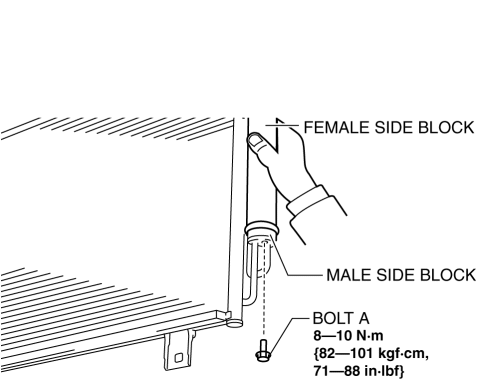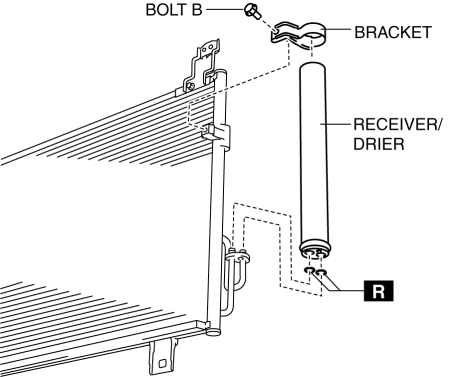Mazda CX-5 Service & Repair Manual: Receiver/Drier Removal/Installation
1. Disconnect the negative battery cable..
2. Discharge the refrigerant..
3. Remove the front under cover No.1..
4. Drain the engine coolant..
5. Remove the following parts:
a. Plug hole plate.
b. Air cleaner, air hose and fresh air duct component.
c. Coolant reserve tank.
d. Cooling fan component.
e. Radiator.
6. Remove the condenser..
7. Disconnect the block joint type pipes by grasping female side of the block with hand holding firmly then loosen the connection bolt A.

8. Remove bolt B.

9. Remove the bracket.
10. Remove the receiver/drier. Do not allow compressor oil to spill.
CAUTION:
-
If moisture or foreign material enters the refrigeration cycle, cooling ability will be lowered and abnormal noise will occur. Always immediately plug all open fittings after removing any refrigeration cycle parts to keep moisture or foreign material out of the cycle.
11. Install in the reverse order of removal.
12. Inspect for engine coolant leakage..
13. Perform the refrigerant system performance test..
Receiver/drier Installation Note
1. After replacing the receiver/drier, add compressor oil to the refrigeration cycle.
-
Supplemental oil amount (approx. quantity)
-
2 ml {2 cc, 0.1 fl oz}
 Power Metal Oxide Semiconductor Field Effect Transistor (Power Mos Fet) [Full
Auto Air Conditioner]
Power Metal Oxide Semiconductor Field Effect Transistor (Power Mos Fet) [Full
Auto Air Conditioner]
Purpose
The power MOS FET controls the blower motor rotation speed.
Function
The power MOS FET controls the supply voltage to the blower motor based on
the gate voltage sent fro ...
 Refrigerant Charging
Refrigerant Charging
CAUTION:
Do not use a different type of refrigerant or charge beyond the specified
level. Otherwise, cooling ability will be lowered and the A/C compressor could
be damaged.
Chargi ...
Other materials:
Evaporative Emission (Evap) Control System
Purpose, Outline
Prevents release of evaporative gas into the atmosphere.
The intake manifold vacuum introduces evaporative gas to the intake manifold
via the charcoal canister and the purge solenoid valve.
System Diagram
U.S.A. and CANADA
Except U.S.A. and CANADA
...
Auto Dimming Mirror Removal/Installation
1. Disconnect the negative battery cable..
2. Remove the screw B.
3. Remove the auto-dimming mirror in the direction of arrow (1) shown in the
figure.
4. Detach tabs while push the cover No.2 in the direction of the arrow (2) shown
in the figure, then remove the cover No.2 in the d ...
Antenna Feeder No.3 Removal/Installation
1. Disconnect the negative battery cable..
2. Remove the following parts:
a. B-pillar lower trim.
b. Front seat belt adjusting cover.
c. Front seat belt upper anchor installation bolt.
d. B-pillar upper trim.
e. Trunk board.
f. Trunk end trim.
g. Trunk side trim.
h. D-pillar trim. ...
